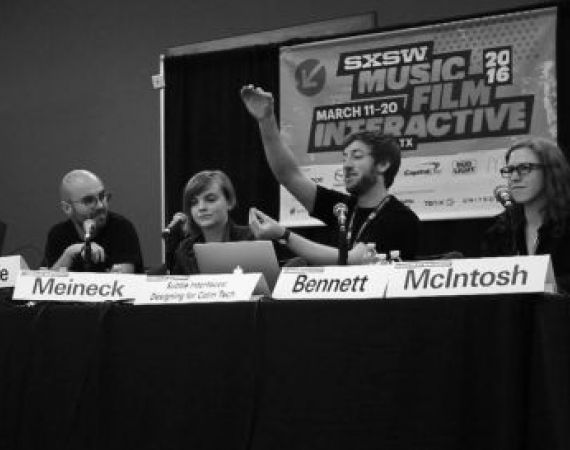Posted on Thu 24 Mar 2016
Notes from SXSW 2016
Last week three Studio residents, Chloe Meineck, Peter Bennett, Tom Metcalfe and I shipped out to sunny Texas for the annual SXSW Interactive Festival.

Studio residents at SXSW
Posted by
Last week three Studio residents, Chloe Meineck, Peter Bennett, Tom Metcalfe and I shipped out to sunny Texas for the annual SXSW Interactive Festival, where we had been selected to give a panel on Subtle Interfaces: Designing for Calm Tech.
Southby (as it is affectionately known) is a massive, billowing, cacophony of talks, expos, events, product launches and hot and cold running barbequed meats that would be impossible to capture in any kind of complete way, so here are a few notes of the things that caught my interest throughout the week:
(forewarning – this is a bit of long read – I recommend skimming down through the bold type titles and dipping into the bits that most appeal to you)
Hidden in Plain View: Discovering Lo-fi Magic
Kelli Anderson, Creative Resident at Adobe
An interesting rallying cry here to embrace lo-tech and tactile solutions to experiences that might sit more naturally in the digital, app-y, online space. Kelli showed some charming examples of her own work from the well shared pin-hole camera pop-up book and ‘This book is a planetarium’ paperworks, to ‘The Existential Calculator’, a paper wheel which asks you questions to determine whether you should ‘take that job?’.
Whilst nicely realised and well documented, some of these projects felt a little throwaway, designed more to generate a sharable film than to offer anything meaningful (when it transpired that you have to use your smart phone camera to capture and invert the images captured on the pinhole camera, with no note of irony, my heckles went up a bit). I was more impressed by a wedding invitation she had designed for a friend, which used a clever bit of paper folding and hidden needle to transform the invite into a record player that when spun played a silly song recorded by the happy couple. I liked the fact that this took a form factor (the wedding invitation) that is still predominantly given in physical form to be kept on a mantlepiece, fridge or mirror, and used new techniques to embue it with a little dose of whimsy and magic.
Bot Party
Coldtowne Theatre and Red Sky Robotics
If, like me, you didn’t win the raffle to go and see Obama talk about Apple, the FBI, and reusable nappies (alright, diapers – ugh), you had to find something else to do on Friday afternoon at Southby. Me? I chose to find out whether ‘Annabelle, an original intelligent conversational robot run through a network of Android tablets, and AVA, a tabletop robot laden with visual sensors, thermal vision and caterpillar tracks’ can come up with hilarious and relevant one-liners on the spot when performing alongside a seasoned improvisational comedy troupe.
The answer is….no, no they cannot. The robots almost immediately broke down and the performers, despite their improv routes, seemed almost incapable of dealing with deviation from what was supposed to happen. It was easily the funniest thing I saw all week but for all the excruciatingly wrong reasons!
Culinary Innovation: Tracking Food Trends
Kara Chiles - Whole Foods Market, Lucie Greene – J Walter Thompson Intelligence and Will Levitt – Taste Talks
With our Food Residency programme coming up, I popped along to this talk to find out more about the new big ideas in food. It turned out to be more of a talk about spotting, predicting and responding to trends but there were a few tasty morsels to take away:
On the up (in the US at least)
Algae
Edible insects
Heirloom grains
Bone broth
And on the verge of jumping the proverbial shark
Brussel sprouts
Wooden boards
Bulletproof coffee
So now you know! I also discovered that a Hamburger Milkshake is an actual thing – yikes.
The Brain Electric – Merging Minds & Machines
Malcolm Gay, Boston Globe
A short but interesting talk introducing some of his research into the vanguard of Brain Computer Interfaces, from the creation of synthetic memory by artificially stimulating the hippocampus, to a far-future hypothesis about achieving a type of immortality by shifting from the human > to the cyborg > to computer-stored consciousness > to disembodied consciousness
Weird Startups from Japanese Universities
Masaaki Sugimoto - AgIC Inc, Riki Kitagawa – Hotaru Co, Taketo Sugawara and Yoshihiro Kawahara – Tokyo University
Having just returned from Tokyo installing Playable City commission Shadowing at part of the Media Ambition Tokyo festival with the British Council, my interest was peaked by this slightly quirky title.
There was some great Japanese innovation on show, from the sublime – large scale printable electronics capable of printing onto flexible materials from iPhone-flummoxing fingerprints to room-scale under-floor heating (AgIC) – to the borderline ridiculous – portable shower pods for the busy commuter (Hotaru). The latter example had some nice ideas about re-using shower water to avoid waste but struggled to answer the question “where do you put your clothes?”
Overall, there was a real warmth from the panel and a genuinely held ambition to collaborate more with partners, investors and users around the world so we will definitely keep in touch as our own connections with Japan develop through the Playable City programme.
For the People, By the People: The Human Algorithm
Dave Snowden – Cognitive Edge, Gal Alon – Insights.US, Kerry O’Connor – City of Austin
This was a fascinating and at times refreshingly adversarial debate chaired by the City of Austin’s Chief Innovation Officer, Kerry O’Connor. She stewarded a fast paced conversation between two experts with largely contrasting views on how ethnography, big data, consultation and the use of feedback loops can be used in city planning and serving a broad range of citizens.
I have about 6 pages of notes, but one of my key takeaways from Dave Snowden, was that continuous micro-observations over long periods of time are likely to give more a representative picture than spot-surveys and solicited feedback. Asking people what they think directly has a tendency towards confirmation bias as they interpret what they think you are looking for, or what the 'right answer' is. I suppose this underpins much of the current thinking around smart grids and smart cities but concerns me slightly as it suggest a level of constant monitoring and de-personalisation of data that can be just as open bias and interpretation as any other data set, but is easier to present as ‘fact’.
Why We Crave Touch in Our Interaction with Tech
Ali Israr – The Walt Disney Company, Chad Sampanes – Immersion, Marianna Obrist – University of Sussex, Susan Hassler – IEEE Spectrum
An interesting panel featuring the Bristol-based Ultrahaptics team who we have been experimenting with since their super-early experiments in 2012. The panel suggested that our current use of haptics, mostly in vibrating games controllers and buzzing phones, is insufficient and under-utilising the rich potential of this medium to communicate emotion, nuance and mood.
They described the potential to use more of ‘the vibro-tactile range’, which struck many of us as a useful new way of talking about haptics, and one we’ve already begun chucking around in the Studio.
ANIMA
By Nick Verstand
Tucked away in an unassuming room in the Westin Hotel I discovered an incredible glowing orb, about 9 feet tall made of what looked like hot air balloon fabric, with swirling colourful projected patterns traversing it’s surface like the sulphuric clouds of Jupiter. As I approached the swirling clouds seemed to surge towards me and a sound track playing overhead increased in intensity. As I spent more time with it the swirling calmed, became a more tranquil blue-green and turned its attentions elsewhere.
https://www.youtube.com/watch?v=ukxgB4rwRUg
At the back of the room, creative technologist and software development lead Dirk Broenink told me that they were interested in the sweet spot between interactive installations that have an obvious correlation between the presence of an audience and their responses e.g. I move my hand, it moves, which we tend to read as a machine response; and interactions that are so random or subtle that we don’t believe their behaviour to be responding to us at all, which we also read as a machine response. They are interested in designing installations that appear to know that you are there but will decide for themselves whether to acknowledge you, and what if anything to do next. They theorise that this sweet spot is where we start to infer consciousness, personality, and perhaps even ‘a soul’.
I stayed in this room for a while and people did seem to be looking for the approval of the glowing orb. “Oh, he likes you” or “that didn’t go down very well” were pretty common responses.
Wearing Sound
Ezgi Ucar - Ezgi Ucar Design
Despite the gorgeous visuals and what is probably, in person, a very beautiful interactive dress that Ezgi designed working with dancers; this talk was a little dry. Ezgi focussed heavily on the technologies that she used to set up the dress as a midi controller for sound (Ableton Live and Max MSP). I know I am spoilt, and my experience of such things is hardly typical, but I have seen multiple variations of this before, and better executed, so I was a little underwhelmed.
However, as is often the case at Southby, the most interesting things pop out at the seams of the official programme, and in the Q&A a guy called Daniel Büttner mentioned that he was developing a haptic wristband called ‘Basslet’ that allows you feel music through your body whilst listening on your headphones…and that he had one set up at the back of the room if anyone wanted a go. I put something not dissimilar to an Apple Watch on my wrist which synced up via Bluetooth to the music playing on Daniel's phone and before long, the bassline of the song was pulsating up my arm.
This struck me as a promising technology, offering a more visceral experience of music for hearing and deaf audiences. It would be great to experiment more with this approach in a lab we are running with deaf and disabled artists later in the year so we will definitely be back in touch with the Berlin-based basslet crew later in the year.
Subtle Interfaces: Designing for Calm Tech
Chloe Meineck – Studio Meineck, Peter Bennett – University of Bristol, Tom Metcalfe – Thomas Buchanan, Verity McIntosh
So, this was what we did! I am perhaps not the best person to report on this so here are just a few things other people had to say about our panel:
Amy Rumbarger - @amyrumbarger
Calm tech often, but not always, means screenless interfaces. Subtle doesn't have to mean invisible. #calmtech #SXSW #SXSW2016
Fascinating suggestion that a future ageist deregatory term will be: #glasstapper #CalmTech
Boy! Do we need... #calmtech #SXSW2016 with @veritymcintosh @petebennett @tommetcalfe @ChloeMeineck
Great to see thoughtful projects like @ChloeMeineck 's presented at #CalmTech old.react-hub.org.uk/playsandbox/pr… helping kids write life stories
and a personal favourite of mine from world-renowned writer and legendary SXSW commentator Bruce Sterling who was in the front row:
Bruce Sterling - @bruces
*It may be impossible to get more British-design than this. "Subtle Interfaces:
Designing for Calm Tech" at SXSW 2016 #SXSW #calmtech
You can hear the whole talk on Soundcloud now https://soundcloud.com/officialsxsw/subtle-interfaces-designing-for-calm-tech-sxsw-interactive-2016
We will be sharing a full video in the next few days.
And if that weren’t enough, we will be giving a version of this talk in the lunchtime talk slot at the Studio on 1 April. Come and see it in person and heckle us with your awkward questions. Hope to see y’all there!
A huge thank you to Invest Bristol & Bath and UK Trade & Industry SW and University of Bristol, as well as REACT and Playable City at Watershed who supported our visit.
